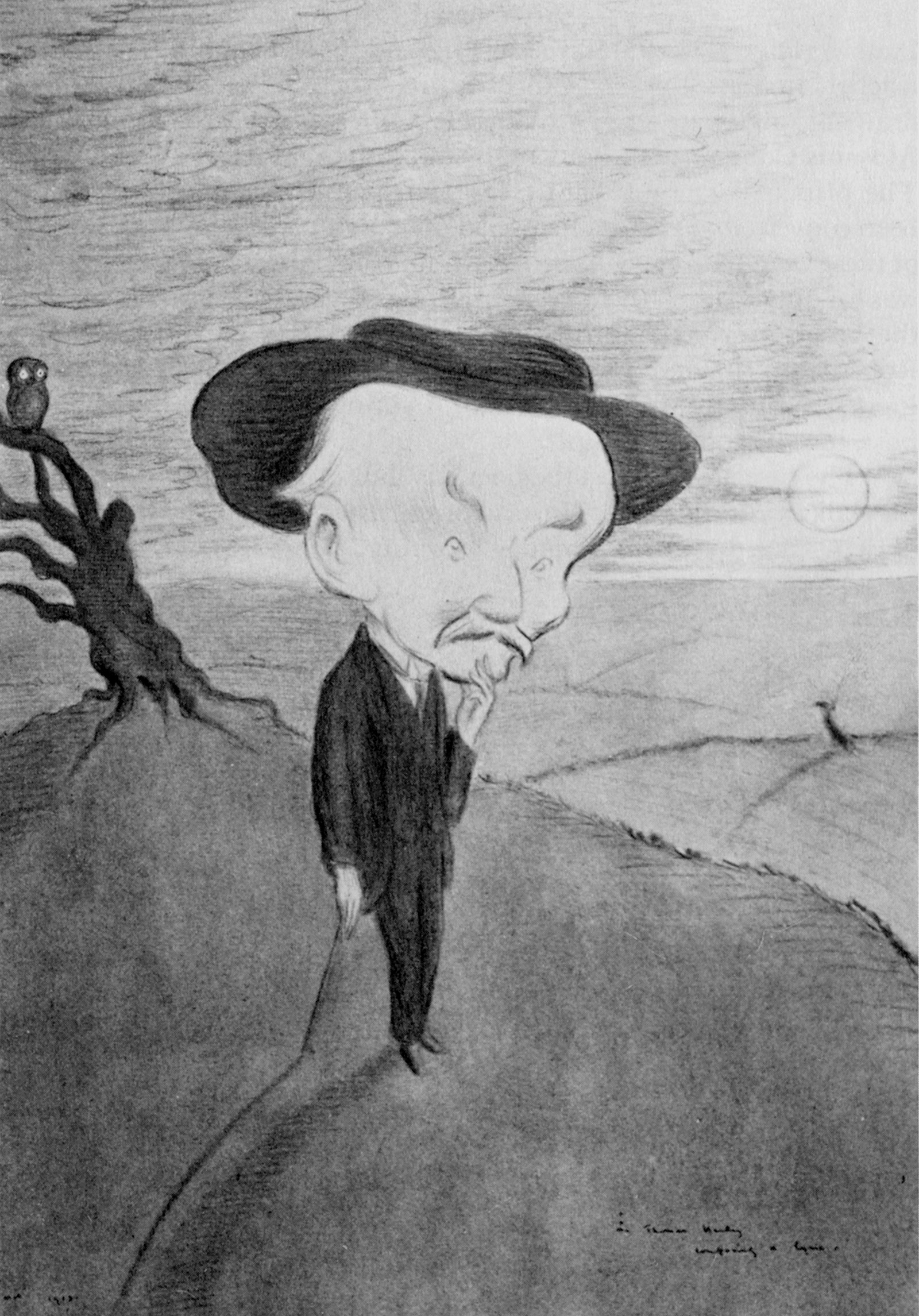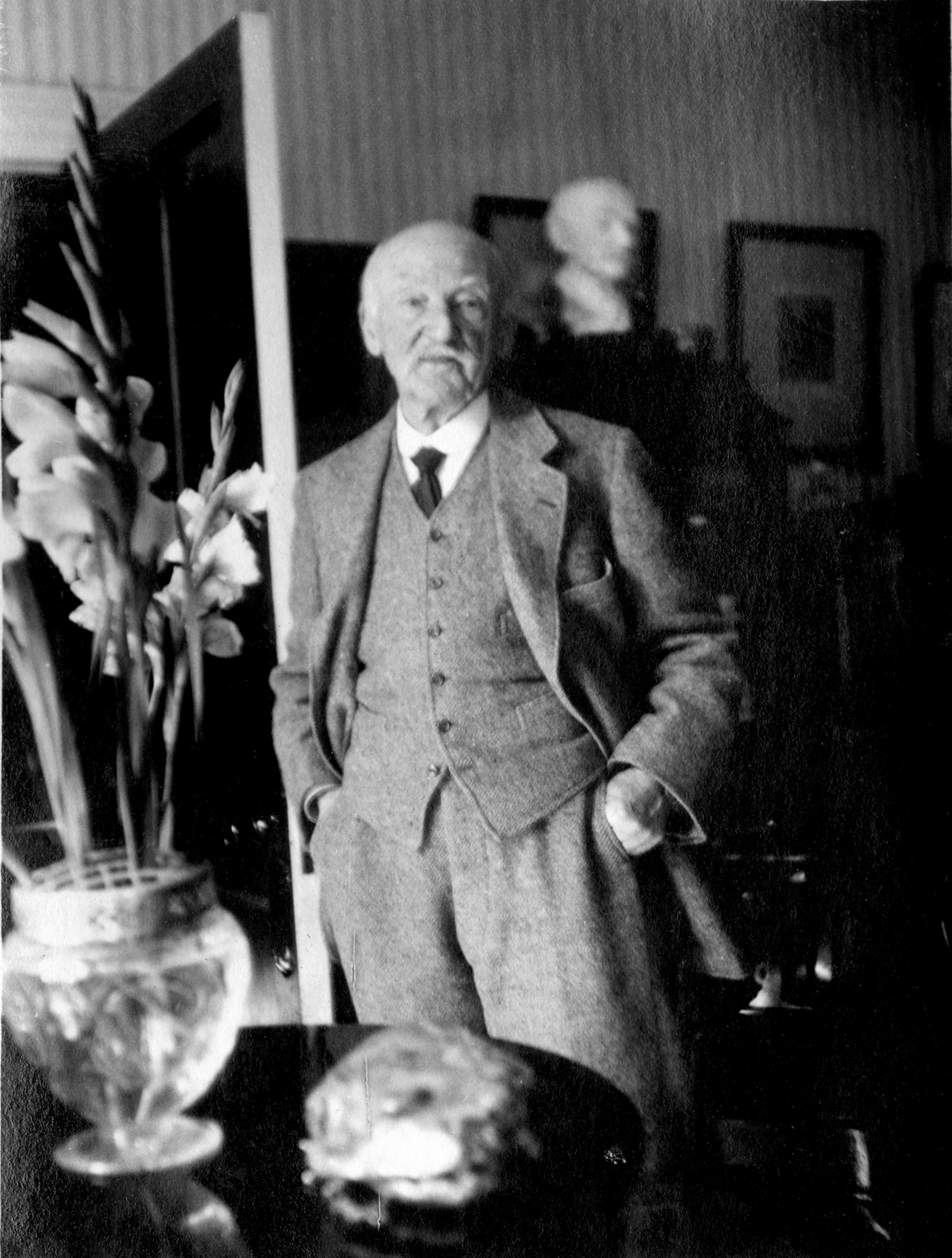To call Thomas Hardy half a Londoner may sound rather like suggesting that William Faulkner was something of a New Yorker. Didn’t Hardy invent the English realm of “Wessex,” or at least rescue it from a thousand years of disuse? Wasn’t he a native of that place, born in a tiny village near Dorchester? He “ventured,” he said in a preface to a new edition of Far from the Madding Crowd, “to adopt the word…from the pages of early English history, and give it a fictitious significance as the existing name of the district once included in that extinct kingdom.”
Then things got a little out of hand, and what Hardy called “a partly real, partly dream-country…solidified into a utilitarian region which people can go to, take a house in, and write to the papers from.” Mark Ford reminds us in the opening pages of his remarkable book that the utilitarian region now displays the name everywhere: “Wessex Auctions, Wessex Building Services, Wessex Cars, Wessex Dental, Wessex Electrical, Wessex Fertility, Wessex Golf Centre….” King Alfred would have been delighted. Or perhaps not.
In any event Hardy himself was fully aware of the advantages of the franchise. “Could you,” he wrote to his publishers in 1888,
whenever advertising my books, use the words “Wessex novels” at the head of the list…. I find that the name Wessex, wh. I was the first to use in fiction, is getting to be taken up everywhere: & it would be a pity for us to lose the right to it for want of asserting it.
Of course one can write about a country, real or dream-bound, without residing in it, but Hardy was raised in what became Wessex and lived there for most of his life. Much of the condescending nonsense written about him relies on what was seen to be his country style. Henry James thought Far from the Madding Crowd was “clever” but deeply unconvincing as far as its human characters went: “the only thing we believe in are the sheep and the dogs.” Somerset Maugham decided that Hardy, even when dressed for a social occasion, had “a strange look of the soil”—whatever that look might be. Leslie Stephen, a great admirer of much of Hardy’s work, found “the descriptions of country life admirable” without looking forward much to anything he might say about the city. Even Stephen’s daughter, Virginia Woolf, while insisting that she saw nothing of “the simple peasant” in Hardy, managed to cast him as an idyllically rustic writer, “naturally swept off into imagining and creating without a thought of its being difficult or remarkable.”
Large myths are in the air here, and they are in no way dispelled by the fact that the claim to be half a Londoner was made by Hardy himself. He was joking about the fact that he and his wife Emma, who lived at Max Gate, a house in Dorchester designed by Hardy himself and built by his father and brother, spent “the Season” in London each year, that is the months of April, May, June, and July. Hardy also liked to call himself “a London man,” but this was a different kind of joke. He meant he was a man from the country who sometimes liked to pretend he wasn’t. “He was elected a member of the Savile Club,” he wrote of himself, “and by degrees fell into line as a London man again.”
He never denied his roots, that is, and never really thought of himself as a suave urban type, but he understood that as a writer he had to live in more than one place mentally, and he did this by shifting about physically too. Ford’s shrewd remark about Hardy’s return to Dorset in ill health after his first five years in London announces a complicated interchange: “It is hard to see how he could have gained, for all his intellectual precocity, the kinds of perspective on Dorset that would eventually enable him to transform it into Wessex.” London, or at least Hardy’s London, allows a rural area to become its own imaginary twin.
Ford tells us that the idea of writing about “the metropolitan aspects” of Hardy’s life and work came to him while he was assembling his anthology of London poetry. He was “surprised to find so many compelling poems by Hardy set in London,” and the present work is an exploration of this surprise. It is, we might say, a whole book about half a Londoner, lending this phrase a wider sense than Hardy himself had in mind. The work is a “portrait,” Ford says, and the portrait in turn conveys an “argument”: “that all of Hardy’s work benefits from being considered in the context of his pressing, at times almost obsessive need to make sense of the relationship between London and the provinces.” “The focus on Wessex,” Ford says, “has obscured the importance of London to [Hardy’s] career and development.”
Advertisement
A whole crowd of stories lurks in the London map we can find between the preface and the introduction. Here is the young Hardy, twenty-two to twenty-seven years old, living in remote Kilburn and then in slightly less remote Maida Vale, working in two architects’ offices, first near Covent Garden then between the Strand and the river. Here he is a little older, aged thirty to forty, trying to make a living as a writer, and apart from brief spells in Knightsbridge and Bayswater, taking his distance from the city he still needs to haunt by living in Surbiton, then in Tooting. And finally there is the impressive scatter of lodgings taken by Hardy and his wife for many seasons, from 1884 to 1910: some twenty-three different places in Bloomsbury, Kensington, Belgravia, Marylebone, and for a couple of years, Maida Vale again.
Ford takes us through a series of novels and the situations of their writing—from Desperate Remedies (1871), Under the Greenwood Tree (1872), and Far from the Madding Crowd (1874) to Tess of the d’Urbervilles (1891) and Jude the Obscure (1895)—and shows how they record “the traffic…between Wessex and London.” Notable moments include the glimpse of Tess Durbeyfield caught in the light of the lamps of a passing train—“No object could have looked more foreign to the gleaming cranks and wheels than this unsophisticated girl with the round bare arms, the rainy face and hair, the suspended attitude of a friendly leopard at pause”—and the evocation in The Well-Beloved (1892) of the slabs of Portland stone arriving from the west to be used for London buildings, suggesting to the hero that one day the whole “island rock…would be nibbled all away.” The leopard and the machine, the island and the city—will they ever get along with each other? Will the second in each set devour the first? These are not quite the right questions perhaps. Ford’s book suggests that we should be asking whether they will ever, once they have met, be able to keep out of each other’s way.
It is important to understand, as Ford does so well, that both country and city are imaginary. They are not unreal, they are thoroughly historical, but they are visible only through thick incrustations of fantasy. Ford suggests that Hardy’s subject was often “the pastoral under threat,” and indeed it was. But the readers who loved the novels of this threatened existence were predominantly city-dwellers; and pastoral is a genre, not a mode of country life. Conversely, the demonized city that demolished the good old simple ways was almost everyone’s favorite monster. Hardy wrote of his “years of London buffeting,” he liked to conjure up the “din and sin” of the city, and created perhaps the most vivid image of urban sprawl ever devised: “they stopped at the point now called Swiss Cottage, and looked back at the outside of London creeping towards them across green fields.” Ford says that this picture “has the primal, haunted clarity of a Wordsworthian spot of time, as well as being sound social history.”
This is exactly how imaginary places come to be real, and vice versa. Between the bucolic dream that only half-exists and the urban monster who is only half-awake, “life laughs onward,” as Hardy says in the title of a poem. The creeping city is scary but it doesn’t stop a man from going to his club—in fact, he couldn’t have a club if there weren’t a city.
Hardy thought of himself as a poet, and turned himself into a best-selling novelist because he had a wife and a lifestyle to support. He wrote poems constantly, but published none in book form until he could afford to give up writing fiction. There is some question about whether Jude is Hardy’s last novel or not—the second version of The Well-Beloved (1897) is also a contender—but in either case he published his first book of verse in 1898, and then published only verse until he died in 1928. It’s true that the verse includes the vast epic The Dynasts. This improbable story tells us something about what Ford calls “Hardy’s need at once to gratify and to improve and to police himself.” He knew what he liked, and he thought he knew when he had to deny himself the pleasure. Contradictions and complications are everywhere in the novels and the poems, but the poems have more edges and corners, and often dramatize with remarkable clarity the exact dilemma that Hardy is both confessing and concealing.
Advertisement
The dilemma doesn’t always concern the country and the city. It often involves Hardy’s ambivalence about love, choice, writing, memory, death, and much else, but he has a way of housing these topics in complex structures of opposing but inseparable thought of the kind we have seen in the urban and rural myths of Hardy and others. The structures also appear in small points of diction or prosody. There are so many poems that manage to seem quaint or old-fashioned and bizarrely sharp and economical at the same time. Think of the words “sped,” “nook,” and “forsook” in the following lines from “A Two-Years’ Idyll.” They place us in a comfortable if depressing Victorian world that the phrase “designs smart and tall” snaps us straight out of. Or would if we were not already shaken by the violent line break of “somehow/Life”:
Lost: such beginning was all;
Nothing came after: romance straight forsook
Quickly somehow
Life when we sped from our nook,
Primed for new scenes with designs smart and tall.
There is a similar effect in the “quick glad surprise” of the following stanza from his elegy for Swinburne, “A Singer Asleep,” but the really amazing touch is the combination of the awkward “glassing the sunshine” with the marvelous “bent eyes”:
O that far morning of a summer day
When, down a terraced street whose pavements lay
Glassing the sunshine into my bent eyes,
I walked and read with a quick glad surprise
New words, in classic guise.
It’s almost too obvious, Hardyesque one might say, to rhyme “the Maytime” with “our long cold claytime,” but the sheer lugubrious plod of the idea (and the sound) does all kinds of work, including a quiet mocking of the morbid mood itself. And no one is wilier or more subtle than Hardy when he frames his reluctance to engage with the messy business of self-surrender in love:
Out of the night there looms a sense ’twere better
To fail obtaining whom one fails to miss.
Discussing these and many other poems in illuminating ways, Ford always bears in mind what he calls Hardy’s “love of the freakish, the extravagant, the convoluted, the discordant.” Something is always out of tune here, even when the tune is beautiful. Sometimes the humor is a little harsh, as in the gleeful, romping “Sergeant’s Song,” where Napoleon plays the part of a redeemer who cannot come:
When Lawyers strive to heal a breach,
And Parsons practise what they preach…When Justices hold equal scales,
And Rogues are only found in jails…When Rich Men find their wealth a curse,
And fill therewith the Poor Man’s purse…When Husbands with their Wives agree,
And Maids won’t wed from modesty…
That’s when Little Boney will “come pouncing down,/And march his men on London town!” But why would the invasion be invited by what sounds like a moral improvement?
Sometimes the imagery is too intricate and overworked to represent the supposedly depicted anger or grief, but unforgettable for just that reason:
The smile on your mouth was the deadest thing
Alive enough to have strength to die.
And sometimes he is just lying, so transparently that all we can feel is the distress:
I am just the same as when
Our days were a joy, and our paths through flowers.
He is writing about his first wife shortly after her death—they had been miserably estranged for years before that. Their days were a joy soon after their marriage, but not for long. And he is not just the same; nor anywhere near it. He can scarcely remember, except in this and other moments of haunted self-pity, what such sameness might mean. But then, how pathetically eloquent the lie is.
There are two moments in The Life and Work of Thomas Hardy, almost entirely written by himself but cast in the third person and initially published under his second wife’s name, when the writer refers to Proust. The subject is the same each time, Hardy’s “theory” that “the ideal loved one…only exists in the lover…as exemplified also by Proust many years later.” Hardy himself developed the theory in the plot of The Well-Beloved, and in an extraordinarily creepy poem of the same name. The speaker is on his way to see his fiancée, singing as he goes, when he meets a spirit who resembles the lady in question. Is it the lady herself? The spirit reassures him but only in the backhanded way that anyone gets reassured in Hardy. She is not his fiancée, but she is the one he really loves: “Thou lovest what thou dreamest her/I am thy very dream!” When he arrives at his destination, his fiancée no longer seems so attractive: “Her look was pinched and thin,/As if her soul had shrunk and died,/And left a waste within.”
Later in the Life Hardy quotes two passages from À l’ombre des jeunes filles en fleur. In English they read: “Few people understand either the purely subjective character of the phenomenon of love, or how it creates a supplementary person who is quite different from the one who bears our beloved’s name in the outside world, and is mostly formed from elements within ourselves”; and “Desire arises, satisfies itself, disappears—and that’s all. Thus, the girl whom one marries is not the person with whom one fell in love.”
The curious thing is that when Proust has his narrator talk about Hardy in a later volume of À la recherche, he is not discussing this phenomenon but the recurrence of certain patterns in Hardy’s plots, especially in relation to stonemasons. I remembered this detail before I looked the passage up, but had forgotten the real drama of the occasion. The narrator is giving Albertine a literary lecture, and compares the composer Vinteuil to Hardy. Then, thinking of Vinteuil’s importance to Swann and Odette, he interrupts himself to ask Albertine if she knows their daughter Gilberte. Albertine says she thinks she remembers the moment when Gilberte kissed her and asked her if she liked women.
The narrator gets flustered, and imagines that Albertine’s offhand tone conceals all kinds of deviant behavior. Things get worse when Albertine adds that she decided to lead Gilberte on a bit, and said yes. “But we didn’t do anything.” The narrator is now sure the situation is as bad as can be imagined, but reports that “restraining myself so as not to seem to attach any importance to the matter, I came back to Thomas Hardy’s stone-cutters.”
I don’t know whether Hardy read this passage, but if he did he would have seen in it the sort of fable he was always on the lookout for. Here we have two themes competing for the same space, an accidental interruption full of oblique meaning, the conscripted ghost of a writer who is still alive, a massive pretense of indifference, and a startling reversal of roles. Thomas Hardy, the expert on failing to fail, is reduced to a refuge, something to talk about when one can’t talk about love.





